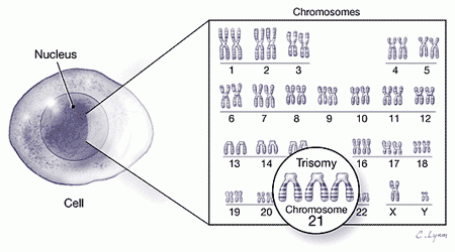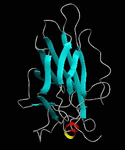This web page was produced as an assignment for Gen677 at UW-Madison Spring 2009
Down's Syndrome
Figure 1: Child with Down's Syndrome

Down's Syndrome is most often associated with the presence of an extra copy of the 21st chromosome in humans (as seen in Figure 2) This over-dosage of the genes on the chromosome leads to physical traits of weakened muscles, shorter stature, a slanting of the eyes in an upward direction, and a single crease in the palms of the hands. Another common characteristic of people affected by Down's Syndrome is cognitive delays, which can vary in degree of severity.(1) In some cases, persons affected with Down's Syndrome can experience severe medical problems beyond the normal symptoms associated with the disease. Around half of the children diagnosed with Down's Syndrome will also be afflicted with congenital heart defects, and losses of hearing and vision. A whole host of other conditions can also be attributed to the disease including: "thyroid problems, obesity, and increased susceptibility to infection, and a higher risk of childhood leukemia".(2)
Figure 2: Human chromosomes
NFATc and Down's Syndrome
NFATc (Nuclear Factor of Activated T-cells) is and important regulator involved in a crucial pathway leading to proper vertebrate development. In Trisomy-21 individuals and over expression of DYRK1A and DSCR1 proteins, which together reduce the transcription abilities of NFATc. This inhibition in NFATc activity has been shown to have direct relations to Down's Syndrome. (4)
References:
1. National Down Syndrome Society (2009). About Down Syndrome: Down Syndrome Fact Sheet. Retrieved February 2, 2009, from http://www.ndss.org/index.php?option=com_content&view=category&id=35&Itemid=57
2. Nemours Foundation (1995-2009). Down Syndrome.Retrieved February 10, 2009, from http://kidshealth.org/parent/medical/genetic/down_syndrome.html
3. Ranger et al. (Jan 3, 2000) The Nuclear Factor of Activated T Cells (Nfat) Transcription Factor Nfatp (Nfatc2) Is a Repressor of Chondrogenesis. JEM v.191. Retrieved February 10, 2009 from http://www.pubmedcentral.nih.gov/articlerender.fcgi?artid=2195796
4. PHG Foundation (5 June 2006). Down's Syndrome and the role of NFAT signaling pathway. Retrieved February 2, 2009, from http://www.phgfoundation.org/news/2518/
5. (Figure 1) Santa Barbra City College (2002). Annual Faculty Lecture: Dr. Janet Shapiro 2003-2004. Retrieved February 2, 2009, from http://www.4sbccfaculty.org/lecture/2000s/lectures/Jan_Shapiro.html
6. (Figure 2) Neurocognitive Development Lab (2005). Research Projects in Down Syndrome. Retrieved February 2, 2009, from http://psychology.ucdavis.edu/labs/rivera/site/research/down.htm
7. (Figure 3) President and Fellows of Harvard College (2004). The Wagner Lab: at Harvard Medical School. Retrieved February 2, 2009, from http://gwagner.med.harvard.edu/index.php?option=com_frontpage&Itemid=1
Margaret Noll, [email protected], last updated 3/5/2009, http://www.gen677.weebly.com


